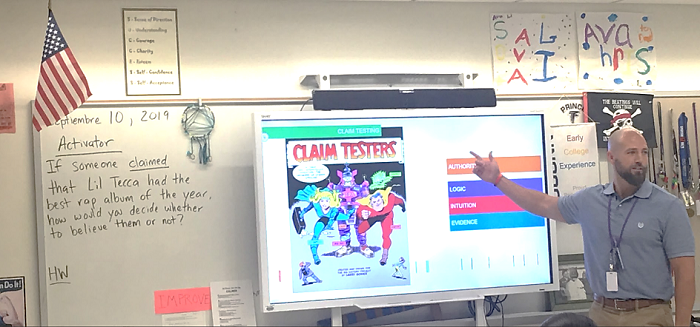Commissioner's Comments by Dr. Miguel A. Cardona
Bridging the Cultural Divide
Does Lil Tecca have the best rap album of the year? That was the question on the board for the Prince Technical high school seniors who were engaging in a conversation about claims. Their teacher, Christopher Morgan, was getting them engaged in a topic that they are all very much aware of, whether Lil Tecca’s album should be consideredthe best rap album of the year. Some students commented that while the album is good, so far only one song this year made it to number one. Further, the album that is currently at number two, from Travis Scott, has had several number one hits for multiple weeks.

The students were being asked to support their claim with evidence. That meant that they had to Google the number of weeks that Lil Tecca was number one versus the number of weeks that Travis Scott was previously at number one. They also had to articulate their position with authority, logic, intuition, and evidence. The point in this is that, for most of the readers, you don’t know who Lil Tecca is. For the 16-17 year old students, that is what connected them to this lesson on claims and evidence.
Their teacher, Mr. Morgan, was able to bring out something that was culturally relevant to the students in order to engage them.
Interestingly, when I got home that night, I asked my 14 year old son the same question about Lil Tecca, and he shared his thoughts. The next day, at 6:45 am, as I was taking him to school, it was still on his mind. He started talking about the song that is currently at number one written by Lil Tecca. For those of you that work with teenage boys, you know that getting them to talk that early in the morning is somewhat of a miracle.
How do we engage students in the things they find relevant when we teach? How do we lead schools and districts with student interest at the core of our decisions? As we examine the instructional core which includes connections with student, we need to recognize that there is much work to be done connecting the content to student interests. Many students feel disengaged, disconnected, and frankly, bored, partly because there is still work to be done in bridging the cultural divide. Notice I did not mention the race of the teacher at the helm of the lesson on claims and evidence. It is irrelevant here. This teacher, Mr. Morgan knew that connecting to what students value would get them more engaged in the lesson. This teacher knew that if he started with something the students liked, he would get the best out of them.
Are our classrooms, schools, and districts set up similarly? In the design of the lesson, Mr. Morgan thought carefully about how to connect with students. How do we do that when we create policy, practice, or activities in our schools? Leaders, consider having a group of students that reflect the diversity of your school as a part of an advisory board when making major decisions—then listen and incorporate their thoughts. In the classroom, ask students which topics interest them. Connect the teaching to interests that you can gather from a quick survey you administer several times a year. As we reflect on the instructional core, we must understand the importance of student connections. What I learned from my visit to Mr. Morgan’s class is that time and energy spent on closing that cultural divide can result in higher student engagement and ultimately higher student success. I also learned that high schoolers still think that Travis Scott can claim the best rap album of 2019.
For more information on engaging student voice and culturally relevant pedagogy, visit the State Education Resource Center (SERC) at https://ctserc.org/ or contact SERC’s ExecutiveDirector Ingrid Canady at (860) 632-1485 x265.
